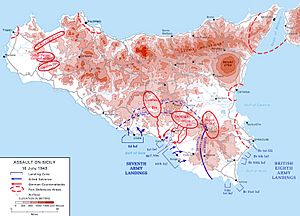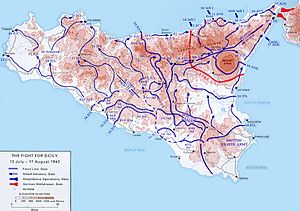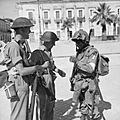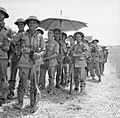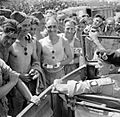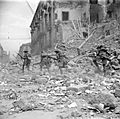Allied invasion of Sicily facts for kids
Quick facts for kids Sicilian Campaign |
|||||||
|---|---|---|---|---|---|---|---|
| Part of the Italian Campaign of World War II | |||||||
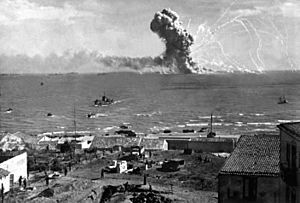 The U.S. Liberty ship Robert Rowan explodes after being hit by a German bomber off Gela, Sicily, 11 July 1943 |
|||||||
|
|||||||
| Belligerents | |||||||
|
|
Axis: |
||||||
| Commanders and leaders | |||||||
| Strength | |||||||
| Initial Strength: 160,000 personnel 14,000 vehicles 600 tanks 1,800 guns Peak Strength: 467,000 personnel |
230,000 Italian personnel 40,000 - 60,000 German personnel 260 tanks 1,400 aircraft |
||||||
| Casualties and losses | |||||||
| 24,850 casualties (5,837 killed or missing, 15,683 wounded, 3,330 captured) |
~20,000 casualties 131,359-147,000 killed, wounded and captured (mainly POWs) |
||||||
The Allied invasion of Sicily was a major battle during World War II. It was also known as Operation Husky. The Allied forces took control of Sicily from the Axis Powers. These powers included Italy and Nazi Germany.
This operation involved a huge attack by sea and air. It was followed by six weeks of fighting on land. Operation Husky marked the start of the Italian Campaign. After Sicily, the Allies moved on to invade mainland Italy.
Operation Husky began on the night of July 9–10, 1943. It ended on August 17, 1943. The Allies achieved all their goals. They removed Axis air, land, and naval forces from the island.
This victory also opened up the Mediterranean Sea for Allied ships. A big result was that Italy's leader, Benito Mussolini, was removed from power for a short time.
Contents
Why Sicily Was Important
Allies Plan Their Attack
The plan for Operation Husky was to attack Sicily from the sea. Two large armies would land on different parts of the island's coast. One army would land on the southeastern coast. The other would land on the central southern coast.
Naval ships would fire their guns to help the soldiers land. Bombers would also attack enemy positions from the air. The overall commander for this operation was American General Dwight D. Eisenhower.
The Allied land forces came from the American, British, and Canadian armies. They were split into two main groups. General Bernard Montgomery led the Eastern Task Force. Lieutenant General George S. Patton commanded the Western Task Force. Besides landing from ships, airborne troops were also part of the plan. These troops would parachute in to capture important bridges and high ground.
The Allied naval forces were also divided into two groups. Their job was to transport the invading armies safely to the beaches.
Axis Defenses in Sicily
The island of Sicily was defended by the Italian 6th Army. General Alfredo Guzzoni was their commander. In early July, the Axis forces on Sicily included about 200,000 Italian soldiers. There were also about 32,000 German troops. An additional 30,000 German air force ground staff were present. By late July, the number of German troops had grown to 70,000.
How the Attack Was Planned
The final attack plan was created on May 17. Earlier, in January 1943, leaders from the US and Britain met. This meeting was called the Casablanca Conference. They discussed their future war plans. The British leaders really wanted to invade Sicily. General Eisenhower was chosen to be the Commander-in-Chief of all Allied Forces for this mission.
Getting Ready for the Invasion
After the Axis forces were defeated in Tunisia, Allied bombers started attacking. They targeted airfields in Sardinia, Sicily, and southern Italy. They also bombed factories in southern Italy. Important ports like Naples, Messina, Palermo, and Cagliari were also bombed.
Tricking the Enemy
To make the Axis forces think the Allies would attack somewhere else, several trick operations were carried out. The most famous one was called Operation Mincemeat. The British let a dead body, dressed as a British officer, wash ashore in Spain. This body carried a briefcase with fake secret documents.
These fake documents said the Allies planned to invade Greece and Sardinia. They claimed there were no plans to invade Sicily. The Germans believed these documents were real. Because of this, the Germans moved many of their defenses from Sicily to Greece. This made the real invasion of Sicily easier for the Allies.
The Battle Begins
On the night of July 9–10, two British and two American airborne attacks took place. Their main goal was to capture a bridge over the River Anape. However, strong winds caused many paratroopers to land in the wrong places.
Despite this, some airborne troops fought bravely. A small group managed to capture the bridge. They held it against enemy counterattacks for several hours.
The strong winds also made the sea landings difficult. But on July 10, landings were successfully made on twenty-six main beaches.
By the evening of July 10, all seven Allied divisions were ashore. The important port of Syracuse had also been captured.
General Alexander's plan was to secure a strong line. This line would stretch between Licata and Catania. His main goal was to capture key ports on the island.
Images for kids
-
Allied leaders in the Sicilian campaign. General Dwight D. Eisenhower meets in North Africa with (foreground, left to right): Air Chief Marshal Sir Arthur Tedder, General Sir Harold Alexander, Admiral Sir Andrew Cunningham, and (top row): Mr. Harold Macmillan, Major General Walter Bedell Smith, and unidentified British officers.
-
British troops of the 6th Battalion, Durham Light Infantry, part of the British 50th Division, with an American paratrooper of the 505th Parachute Infantry Regiment, part of the U.S. 82nd Airborne Division, in Avola, 11 July 1943
-
Italian soldiers of the 206th Coastal Division, taken prisoner by British forces. Typical of the second-rate equipment issued to the Coastal divisions, they are wearing Adrian helmets of World War I vintage, rather than the more modern M 33.
-
Sherman tank of the 3rd County of London Yeomanry (Sharpshooters) in the village of Belpasso near Catania, Sicily, August 1943
-
Men of the 6th Battalion, Royal Inniskilling Fusiliers, British 78th Division, await orders to move into Centuripe, Sicily, 2 August 1943.
-
General Montgomery stops his car to talk to men of the Royal Engineers working on a road near Catania, Sicily, August 1943.
See also
 In Spanish: Invasión aliada de Sicilia para niños
In Spanish: Invasión aliada de Sicilia para niños


